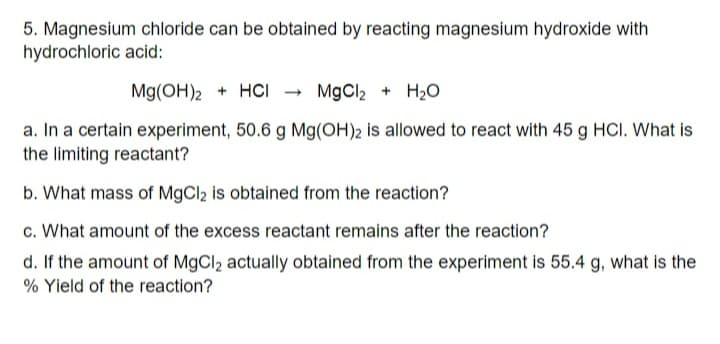5. Magnesium chloride can be obtained by reacting magnesium hydroxide with hydrochloric acid: Mg(OH)2 + HCI → MgCl2 + H20 a. In a certain experiment, 50.6 g Mg(OH)2 is allowed to react with 45 g HCI. What is the limiting reactant? b. What mass of MgCl2 is obtained from the reaction? c. What amount of the excess reactant remains after the reaction? d. If the amount of MgCl2 actually obtained from the experiment is 55.4 g, what is the % Yield of the reaction?
5. Magnesium chloride can be obtained by reacting magnesium hydroxide with hydrochloric acid: Mg(OH)2 + HCI → MgCl2 + H20 a. In a certain experiment, 50.6 g Mg(OH)2 is allowed to react with 45 g HCI. What is the limiting reactant? b. What mass of MgCl2 is obtained from the reaction? c. What amount of the excess reactant remains after the reaction? d. If the amount of MgCl2 actually obtained from the experiment is 55.4 g, what is the % Yield of the reaction?
Chemistry & Chemical Reactivity
9th Edition
ISBN:9781133949640
Author:John C. Kotz, Paul M. Treichel, John Townsend, David Treichel
Publisher:John C. Kotz, Paul M. Treichel, John Townsend, David Treichel
Chapter4: Stoichiometry: Quantitative Information About Chemical Reactions
Section: Chapter Questions
Problem 15PS: The reaction of methane and water is one way to prepare hydrogen for use as a fuel: CH4(g) + H2O(g) ...
Related questions
Question
solve completely for an upvote.

Transcribed Image Text:5. Magnesium chloride can be obtained by reacting magnesium hydroxide with
hydrochloric acid:
Mg(OH)2 + HCI → MgCl2 + H2O
a. In a certain experiment, 50.6 g Mg(OH)2 is allowed to react with 45 g HCI. What is
the limiting reactant?
b. What mass of MgCl2 is obtained from the reaction?
c. What amount of the excess reactant remains after the reaction?
d. If the amount of MgCl2 actually obtained from the experiment is 55.4 g, what is the
% Yield of the reaction?
Expert Solution
This question has been solved!
Explore an expertly crafted, step-by-step solution for a thorough understanding of key concepts.
This is a popular solution!
Trending now
This is a popular solution!
Step by step
Solved in 4 steps with 4 images

Knowledge Booster
Learn more about
Need a deep-dive on the concept behind this application? Look no further. Learn more about this topic, chemistry and related others by exploring similar questions and additional content below.Recommended textbooks for you

Chemistry & Chemical Reactivity
Chemistry
ISBN:
9781133949640
Author:
John C. Kotz, Paul M. Treichel, John Townsend, David Treichel
Publisher:
Cengage Learning

Chemistry & Chemical Reactivity
Chemistry
ISBN:
9781337399074
Author:
John C. Kotz, Paul M. Treichel, John Townsend, David Treichel
Publisher:
Cengage Learning

Chemistry: The Molecular Science
Chemistry
ISBN:
9781285199047
Author:
John W. Moore, Conrad L. Stanitski
Publisher:
Cengage Learning

Chemistry & Chemical Reactivity
Chemistry
ISBN:
9781133949640
Author:
John C. Kotz, Paul M. Treichel, John Townsend, David Treichel
Publisher:
Cengage Learning

Chemistry & Chemical Reactivity
Chemistry
ISBN:
9781337399074
Author:
John C. Kotz, Paul M. Treichel, John Townsend, David Treichel
Publisher:
Cengage Learning

Chemistry: The Molecular Science
Chemistry
ISBN:
9781285199047
Author:
John W. Moore, Conrad L. Stanitski
Publisher:
Cengage Learning

Chemistry
Chemistry
ISBN:
9781305957404
Author:
Steven S. Zumdahl, Susan A. Zumdahl, Donald J. DeCoste
Publisher:
Cengage Learning


Chemistry: An Atoms First Approach
Chemistry
ISBN:
9781305079243
Author:
Steven S. Zumdahl, Susan A. Zumdahl
Publisher:
Cengage Learning